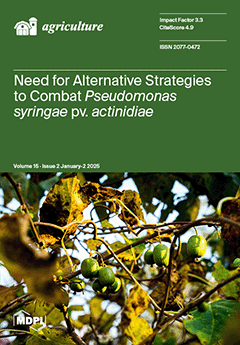The phosphate transporter (PHT) family plays an important role in the uptake and transport of P elements in plants. A total of 158
PbPHTs were identified from the genome of ‘duli’ (
Pyrus betulifolia Bunge) in this study, including 70
PbPHT1s, 2
PbPHT2s, 70
PbPHT3s, 12
PbPHT4s, and 4
PbPHT5s. Among the 158
PHT genes, 150 were localized to 17 ‘duli’ chromosomes. Gene duplication analysis identified 18 tandemly duplicated gene pairs. The promoter analysis showed that there were a large number of cis-acting elements related to phytohormones, growth, development, stress, and light response in
PbPHTs. qRT-PCR analysis revealed that most
PHT genes in ‘duli’ were highly expressed in the fruits, flowers, leaves, stems, and roots, and 15
PbPHT genes were responsive to 5 μM, 0.5 mM, 5 mM H
2PO
4, NaCl, GR24 (synthetic SL analog), GA3 (gibberellin 3), ABA (abscisic acid), and IAA (indole-3-acetic acid). GR24, GA3, IAA, and 5 mM KH
2PO
4 treatments could increase the concentration, absorption, transport, and distribution of P elements in the rhizomes and leaves of ‘duli’, but 5 μM KH
2PO
4, NaCl, and ABA had the opposite effect. This study therefore provides a list of
PbPHT genes with substantial roles in abiotic stress response, as well as important information to understand the functional characteristics of
PbPHT during ‘duli’ abiotic stress tolerance, and explores the function of PbPHTs in exogenous hormones, phosphorus, and salt stress in the future.
Full article





